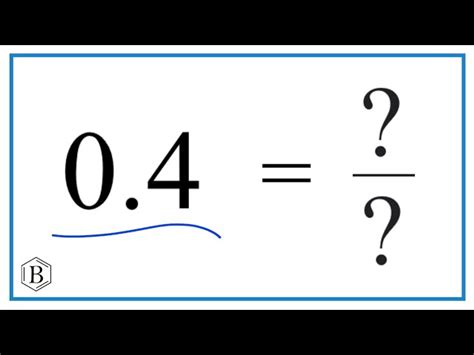What Is 0.4 Repeating As A Fraction
News Co
Apr 01, 2025 · 4 min read

Table of Contents
What is 0.4 Repeating as a Fraction? A Comprehensive Guide
Understanding how to convert repeating decimals, like 0.4444... (often written as 0.4̅), into fractions is a fundamental concept in mathematics. This comprehensive guide will not only show you how to convert 0.4̅ to a fraction but also delve into the underlying principles and provide you with the tools to tackle similar problems. We'll explore various methods, explain the logic behind them, and offer examples to solidify your understanding.
Understanding Repeating Decimals
A repeating decimal, also known as a recurring decimal, is a decimal number that has a digit or a group of digits that repeat infinitely. The repeating part is indicated by a bar placed over the repeating digits. For example:
- 0.333... is written as 0.3̅
- 0.142857142857... is written as 0.142857̅
The repeating pattern can be one digit, two digits, or any number of digits. Understanding this notation is crucial before we proceed to converting them into fractions.
Method 1: Using Algebra to Solve for x
This is a classic and widely used method for converting repeating decimals to fractions. Let's apply it to our example, 0.4̅:
-
Let x = 0.4̅ This assigns a variable to the repeating decimal.
-
Multiply by 10 to shift the decimal point one place to the right: 10x = 4.4̅
-
Subtract the original equation (x = 0.4̅) from the new equation (10x = 4.4̅):
10x - x = 4.4̅ - 0.4̅
This cleverly eliminates the repeating part:
9x = 4
-
Solve for x:
x = 4/9
Therefore, 0.4̅ = 4/9.
Method 2: Utilizing the Concept of Geometric Series
This method offers a more advanced perspective and involves understanding infinite geometric series. A geometric series is a series where each term is obtained by multiplying the previous term by a constant value (the common ratio). In our case:
0.4̅ = 0.4 + 0.04 + 0.004 + 0.0004 + ...
This is an infinite geometric series with:
- a = 0.4 (the first term)
- r = 0.1 (the common ratio)
The formula for the sum of an infinite geometric series is:
S = a / (1 - r) (This formula is valid only when |r| < 1)
Substituting our values:
S = 0.4 / (1 - 0.1) = 0.4 / 0.9 = 4/9
Again, we arrive at the fraction 4/9.
Method 3: The Shortcut for Single-Digit Repeating Decimals
For single-digit repeating decimals, there's a quick and easy shortcut:
The fraction is simply the repeating digit over 9. So, for 0.4̅, the fraction is 4/9. This shortcut works because it's a direct application of the algebraic method shown previously.
Extending the Concepts to More Complex Repeating Decimals
The methods explained above are not limited to single-digit repeating decimals. Let's consider a more complex example: 0.12̅3̅
-
Let x = 0.1232323...
-
Multiply by 10 to shift the decimal: 10x = 1.232323...
-
Multiply by 1000 to shift the repeating part: 1000x = 123.232323...
-
Subtract the equation from step 2 from step 3:
1000x - 10x = 123.232323... - 1.232323... 990x = 122
-
Solve for x:
x = 122/990 = 61/495
Therefore, 0.12̅3̅ = 61/495
Practical Applications and Importance
The ability to convert repeating decimals into fractions is not just a mathematical exercise. It has practical applications in various fields:
- Engineering and Physics: Accurate calculations often require fractional representations for precise measurements and calculations.
- Computer Science: Representing numbers in binary and other numeral systems often involves conversions between decimal and fractional forms.
- Finance: Dealing with percentages and interest rates frequently involves working with decimal values that might be represented more precisely as fractions.
- Chemistry: Calculations involving molar ratios and chemical equations benefit from the use of fractions.
Troubleshooting Common Mistakes
- Incorrect identification of the repeating part: Ensure you correctly identify the digits that repeat infinitely.
- Errors in algebraic manipulation: Double-check your steps when solving for 'x' to avoid arithmetic mistakes.
- Misapplication of the geometric series formula: Ensure the absolute value of the common ratio (r) is less than 1 before using the formula for infinite geometric series.
Conclusion: Mastering the Art of Decimal to Fraction Conversion
Converting repeating decimals to fractions is a crucial skill in mathematics with far-reaching applications. This guide has presented multiple methods, from the simple algebraic approach to the more advanced geometric series method, along with practical examples and troubleshooting tips. By mastering these techniques, you'll enhance your mathematical understanding and improve your ability to tackle various mathematical challenges effectively. Remember to practice regularly to build confidence and proficiency in converting repeating decimals into their equivalent fractional representations. The more you practice, the more intuitive and straightforward this process will become. Don't be afraid to experiment with different methods to find the one that works best for you and helps you understand the underlying principles most clearly.
Latest Posts
Related Post
Thank you for visiting our website which covers about What Is 0.4 Repeating As A Fraction . We hope the information provided has been useful to you. Feel free to contact us if you have any questions or need further assistance. See you next time and don't miss to bookmark.